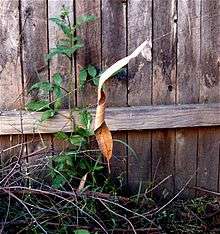Phonognatha graeffei
| Phonognatha graeffei | |
|---|---|
 | |
| Scientific classification | |
| Kingdom: | Animalia |
| Phylum: | Arthropoda |
| Class: | Arachnida |
| Order: | Araneae |
| Family: | Araneidae |
| Genus: | Phonognatha |
| Species: | Phonognatha graeffei Keyserling, 1865 (Australia) |
Phonognatha graeffei, referred to as the Leaf curling spider, is a common Australian spider found in urban areas as well as woodlands in the North-eastern, Eastern and Southern states. A small member of the Araneidae family, the orb-weavers, it was previously placed in Tetragnathidae.[1][2]
They are distinguished by a curled leaf at the web's centre. The species form pairs living together in the same leaf though at opposite ends of their shelter, even before mating at maturity.[3] The female creates a separate curled leaf "nursery" hung in foliage nearby.
Appearance

The body length of the male is 5 to 6mm and female 8 to 12mm. Males and females look very similar with red-brown legs and body and a cream coloured pattern on their backs. Their bodies are fat and oval shaped with long tapered legs.[4][5]
Web
The web with its shelter at the centre, is easily identifiable. The leaf curling spider cleverly weaves a leaf or other object into the centre of its web as a hide-away from birds and other predators. Leaves are twisted along their length to form a funnel, (sometimes with a silk wall on one side, if necessary) that the spider can retreat into. They have also been known to use old snail shells and discarded pieces of paper.[4] Although often found clustered in the same area, each spider has its own web.

The leaf curling spider's web is about 30 cm (a foot) across. It is an incomplete circle, being open at the top and fanning downwards. It suspends its curled up dry leaf in shrubs by supporting threads and the fan-like main web radiates out from this leaf, in which the spider hides in retreat with only the tips of its legs visible to feel the vibrations of insects connecting with the web.[6] It only goes outside its shelter to repair or rebuild its web or if prey falls into the web. It usually rebuilds its web at night.[7]
Behaviour
The leaf-curling spiders are day-active orb weavers protecting themselves from predators by sitting inside a silk seamed, curled leaf. In P. graeffei this leaf is suspended just above the centre of the web, but may be placed higher in other species. Such leaves may be already part curled though many are not, and the spider pulls and silks its leaf into a retreat cylinder, silked shut at the top and open at the hub.[8] Like other web-weaving spiders, their main food source is flying insects[4] including insects larger than itself.[9]
They are noted for their sexual cohabitation and its function in mate-guarding behaviour.[3] This means that the male and female live together in the same curled leaf, each occupying opposite ends of the retreat with the female at the top end.
Mating behaviour
This species is unusual among orb-weaving spiders because males cohabit in the leaf retreat with both immature and mature females, mating with the former shortly after the female molts. Male spiders may take up residence nearby, or in the same web as the (often immature) female. Mating takes place as soon as she has her final molt.

According to Babette F. Fahey, M. A. Elgar,[10] cohabitation may be a form of mate-guarding because resident males challenge rival males that venture onto the web. As well, they consider that the behaviour depends upon the reproductive status of the female since males defending immature females are more aggressive than those defending virgin, adult females.[3]
Males copulate with previously mated females for significantly longer than with virgin females. Females may cannibalise cohabiting males, independently of whether the female has had food and females that cannibalise a single male are not more fertile than non-cannibalistic females.[3]
The female lays its egg sac within a dead leaf, bent over and silked back on itself. This is suspended among foliage well away from the orb web.[8]
Spiderlings
Juvenile spiders start off by bending over a small green leaf, eventually graduating to larger dead leaves (or the occasional other lightweight objects) that are hoisted up from the ground on silk lines at night.[8]
Distribution
The spider is commonly found in open woodland and forest habitats as well as urban and suburban gardens in the North-eastern, Eastern and Southern Australian states.
Phonognatha graeffei and humans
The side-ways action fangs are small and the spider is timid and reluctant to bite.[11] Toxicity to humans is unknown[6] as it is extremely rare for these spiders to bite humans. A bite may result in a localised reaction with pain and swelling, but is not considered dangerous.[4]
References
- ↑ Platnick, N. I. 2008. Araneidae The World Spider Catalog, version 9.0. American Museum of Natural History.
- ↑ Kuntner, M., J. A. Coddington & G. Hormiga. 2008. Phylogeny of extant nephilid orb-weaving spiders (Araneae, Nephilidae): testing morphological and ethological homologies. Cladistics 24: 190.
- 1 2 3 4 Sexual cohabitation as mate-guarding in the leaf-curling spider Phonognatha grae... aus Behavioral Ecology and Sociobiology: Download
- 1 2 3 4 Australia Walkabout Wildlife Park - Wildlife Sanctuary, Sydney Leaf-Curling Spider
- ↑ A picture is available here.
- 1 2 The Find-a-spider Guide - Leaf-curler
- ↑ Leaf Curling Spider - Phonognatha graeffei
- 1 2 3 Araneid leaf-curling spiders
- ↑ Spiderzrule
- ↑ Behavioral Ecology and Sociobiology (1997)
- ↑ Staff Web Page
External links
![]() Media related to Phonognatha graeffei at Wikimedia Commons
Media related to Phonognatha graeffei at Wikimedia Commons
![]() Data related to Phonognatha graeffei at Wikispecies
Data related to Phonognatha graeffei at Wikispecies